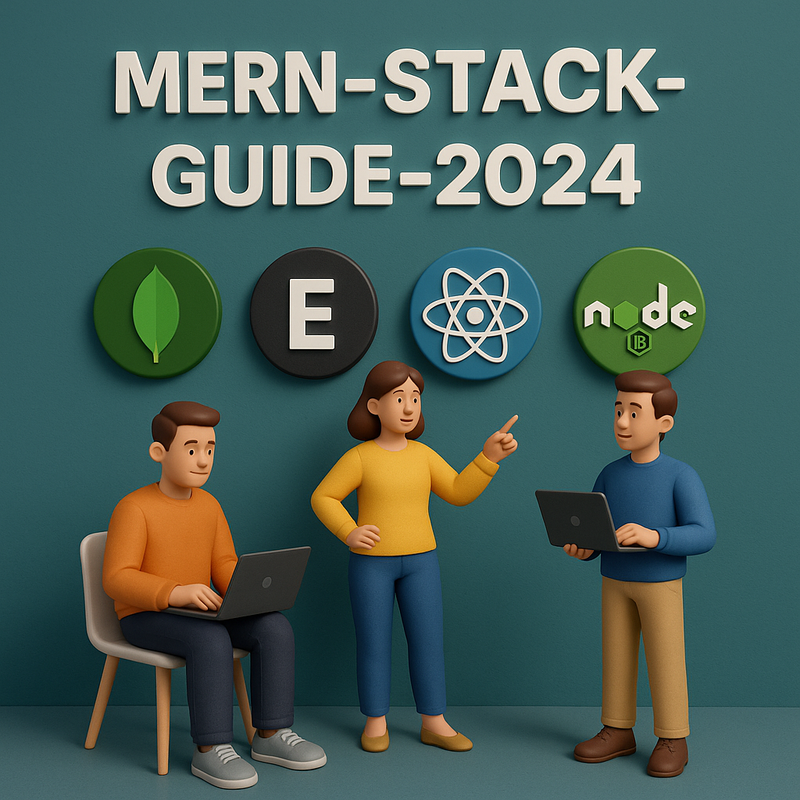Complete MERN Stack Development Guide for 2024
Learn how to build modern web applications using MongoDB, Express.js, React, and Node.js with the latest best practices and tools.

Introduction to MERN Stack
The MERN stack has become one of the most popular choices for full-stack web development in 2024. This powerful combination of MongoDB, Express.js, React, and Node.js provides developers with a complete JavaScript ecosystem for building modern web applications.
Why Choose MERN Stack in 2024?
The MERN stack offers several advantages that make it particularly attractive for modern web development:
- JavaScript Everywhere: Use the same language for both frontend and backend development
- Rich Ecosystem: Access to npm's vast library of packages and tools
- Rapid Development: Faster development cycles with reusable components
- Scalability: Built-in support for horizontal and vertical scaling
- Community Support: Large, active community with extensive documentation
Setting Up Your Development Environment
Before diving into MERN stack development, you'll need to set up your development environment properly:
Prerequisites
- Node.js (version 18 or higher)
- MongoDB (local installation or MongoDB Atlas)
- Code editor (VS Code recommended)
- Git for version control
Essential Tools and Extensions
To maximize your productivity, install these essential tools:
- Postman or Thunder Client for API testing
- MongoDB Compass for database management
- React Developer Tools browser extension
- ES7+ React/Redux/React-Native snippets for VS Code
Building Your First MERN Application
Let's walk through creating a simple but complete MERN application step by step.
Backend Setup with Node.js and Express
Start by creating your backend server:
// server.js
const express = require('express');
const mongoose = require('mongoose');
const cors = require('cors');
require('dotenv').config();
const app = express();
const PORT = process.env.PORT || 5000;
// Middleware
app.use(cors());
app.use(express.json());
// MongoDB connection
mongoose.connect(process.env.MONGODB_URI, {
useNewUrlParser: true,
useUnifiedTopology: true,
});
app.listen(PORT, () => {
console.log(`Server running on port ${PORT}`);
});
Database Design with MongoDB
Design your MongoDB schemas thoughtfully. Here's an example user schema:
// models/User.js
const mongoose = require('mongoose');
const userSchema = new mongoose.Schema({
name: {
type: String,
required: true,
trim: true
},
email: {
type: String,
required: true,
unique: true,
lowercase: true
},
password: {
type: String,
required: true,
minlength: 6
}
}, {
timestamps: true
});
module.exports = mongoose.model('User', userSchema);
Frontend Development with React
Create a modern React frontend using functional components and hooks:
// components/UserProfile.jsx
import React, { useState, useEffect } from 'react';
import axios from 'axios';
const UserProfile = ({ userId }) => {
const [user, setUser] = useState(null);
const [loading, setLoading] = useState(true);
useEffect(() => {
const fetchUser = async () => {
try {
const response = await axios.get(`/api/users/${userId}`);
setUser(response.data);
} catch (error) {
console.error('Error fetching user:', error);
} finally {
setLoading(false);
}
};
fetchUser();
}, [userId]);
if (loading) return <div>Loading...</div>;
return (
<div className="user-profile">
<h2>{user.name}</h2>
<p>{user.email}</p>
</div>
);
};
export default UserProfile;
Best Practices for MERN Development
Follow these best practices to build maintainable and scalable MERN applications:
Code Organization
- Use a clear folder structure separating concerns
- Implement proper error handling throughout your application
- Use environment variables for configuration
- Implement proper logging and monitoring
Security Considerations
- Implement proper authentication and authorization
- Use HTTPS in production
- Validate and sanitize all user inputs
- Implement rate limiting for APIs
- Keep dependencies updated
Performance Optimization
- Implement database indexing for frequently queried fields
- Use React.memo and useMemo for component optimization
- Implement proper caching strategies
- Optimize images and assets
- Use code splitting and lazy loading
Deployment and Production Considerations
When deploying your MERN application to production, consider these important factors:
Backend Deployment
- Use process managers like PM2 for Node.js applications
- Implement proper error logging and monitoring
- Set up automated backups for your database
- Use load balancers for high-traffic applications
Frontend Deployment
- Build optimized production bundles
- Use CDNs for static asset delivery
- Implement proper SEO optimization
- Set up analytics and performance monitoring
Conclusion
The MERN stack continues to be an excellent choice for full-stack web development in 2024. By following the practices and patterns outlined in this guide, you'll be well-equipped to build modern, scalable web applications.
Remember that mastering the MERN stack is an ongoing journey. Stay updated with the latest developments in each technology, practice regularly, and don't hesitate to explore new tools and libraries that can enhance your development workflow.
Happy coding, and welcome to the exciting world of MERN stack development!
Tags
About Abu Sufiyan
Abu Sufiyan is a senior developer and technical writer at OkeanTech, specializing in modern web technologies and best practices. With over 8 years of experience in full-stack development, they enjoy sharing knowledge and helping developers build better applications.
Related Articles
Top Mobile App Development Trends in 2024
Discover the latest trends shaping mobile app development, from AI integration to cross-platform solutions.
Stay Updated
Get the latest insights, tutorials, and industry trends delivered straight to your inbox. Join our community of developers and never miss an update.
No spam, unsubscribe at any time.